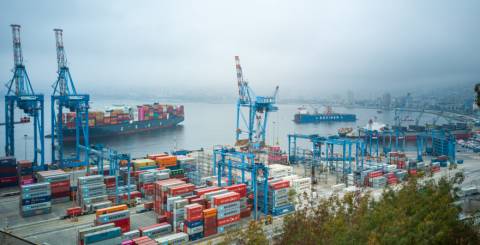Supply Chain Management and Logistics: Key Benefits of IoT

The Internet of Things (IoT) has revolutionized various industries, including supply chain and logistics. Integrating IoT devices, such as sensors and radio-frequency identification (RFID) tags, has provided real-time tracking and monitoring capabilities throughout the supply chain process. It allows for better visibility and control of inventory, assets, and shipments. IoT technology also enables predictive maintenance, reducing downtime and improving overall efficiency. Additionally, data collected from IoT devices can be analyzed to identify patterns and optimize the supply chain process.
The Internet of Things (IoT) has revolutionized managing and monitoring supply chain and logistics operations. Here are some of the benefits IoT brings to supply chain management and logistics:
- Real-time monitoring and tracking: IoT sensors and devices can be used to monitor the location, temperature, humidity, and other environmental factors of goods in transit. It enables logistics managers to track the movement of goods in real time and adjust shipping routes or storage conditions as needed.
- Predictive maintenance: IoT sensors monitor the condition of vehicles, machinery, and other equipment used in logistics operations. This data can be used to predict when care is needed, preventing breakdowns and reducing downtime.
- Improved inventory management: IoT sensors can track inventory levels in real-time, enabling logistics managers to optimize them and reduce the risk of stockouts or overstocks.
- Enhanced security: IoT sensors can monitor cargo containers and trucks, providing real-time alerts if there is any unauthorized access or tampering.
- Improved customer service: IoT sensors can provide customers with real-time updates on the status of their orders, including expected delivery times and any delays.
- Cost savings: By optimizing logistics operations and reducing downtime, IoT can help reduce costs associated with transportation, maintenance, and inventory management.
Overall, integrating IoT in supply chain and logistics can increase transparency, reduce costs, and improve customer satisfaction. Now, allow us to offer you a closer look at the immense potential of IoT for the supply chain and logistics sector:
- Improve efficiency: Incorporating IoT technology in the supply chain allows companies to simplify various tasks, such as locating goods and tracking the movement of raw and finished goods. The technology can also determine transit delays, devise alternate routes, estimate arrival times at specific destinations, and more. IoT in logistics and supply chain management also provides advantages such as improved segmentation, enhanced inventory control, and automated processes. All these abilities, then, ensure enhanced efficiency of supply chain operations.
- Better transparency in inventory management: Inventory management is rendered more transparent and precise with the integration of IoT, as it enables companies to access real-time information about the location and status of every asset, raw material, and finished good. Companies can use this data to monitor and optimize inventory levels in real-time, check inventory status, make informed business decisions, prevent product shortages, and so much more.
- Improved monitoring of storage conditions: IoT technology has also enabled the integration of environmental sensors in logistics, thus allowing companies to track cargo conditions and quickly respond to changes. For example, an IoT-based supply chain system will be able to collate data about pressure, humidity, and temperature inside fleet vehicles — i.e., variables that could compromise the quality of goods — and adjust the environment to maintain the integrity of the products being transported.
- Automation: Today, organizations have come to rely on automation to help minimize the amount of physical labor needed as well as reduce labor costs, mitigate the risk of human error, and accelerate deliveries. With IoT, the supply chain sector has implemented necessary automation in processes. IoT systems are now also using drones to manage warehouses.
Undoubtedly, the idea of integrating advanced technologies, especially one as seemingly complex as the Internet of Things, may seem a tad overwhelming at the outset. Thankfully, as the discussion above demonstrates, the many advantages that the Internet of Things (IoT) brings to the table for the supply chain and logistics industry make it well worth the effort and investment. From substantially improved inventory management to the ability to keep an eye on the operations, including the fleet, in real-time — there is so much that the Internet of Things stands to do for this sector in particular. So, what are you waiting for? Go ahead and start looking for an expert IoT app development services vendor and immediately integrate this technology into your supply chain and logistics operations.
Similar Articles
Anyone even vaguely familiar with today's fast-paced digital world would know that e-commerce businesses face intense pressure. Pressure to deliver exceptional customer experiences while also maximizing their profits. To achieve this delicate balance, companies operating in this space must now put the power of technology to work
Intelligent technology-driven solutions are now guiding industries across all sectors. Innovative and disruptive technologies like Artificial Intelligence (AI) and Machine Learning (ML) are driving these changes, which play a crucial role in designing and developing intelligent solutions.
The introduction of Artificial intelligence (AI) healthcare has caused a radical change in the way that medical care is provided. It gains paramount importance when it comes to customised treatment regimens.
Graphical presentation of data and information in visual formats like charts, maps, and graphs is termed data visualization. This method makes complex data more accessible and easily understandable bringing out the trends and patterns from raw data, which can be used to significantly enhance customer experience
Integrating AI into your business app isn't just a matter of staying current; it's about unlocking new dimensions of efficiency, personalization, and customer satisfaction. Among the most groundbreaking AI technologies is ChatGPT, a language model that simulates human conversation with incredible accuracy.
In the race to deliver high-quality software faster, automation isn’t just an option—it’s essential. Are you tired of slow, error-prone testing? It's time to let automation accelerate your software development and deliver top-notch quality more quickly.
The convergence of sports and technology has ignited a transformative era, where data-driven insights are reshaping the athletic landscape. Artificial intelligence (AI) and machine learning (ML) are at the heart of this, which have transcended mere buzzwords to become indispensable tools in sports app development
With 84% of businesses leveraging AI to establish a competitive edge, it's evident that AI is res
In security management, overseeing the multifaceted operations of security guards can be daunting. Integrating all-in-one security guard software into your portfolio can be a game changer.









